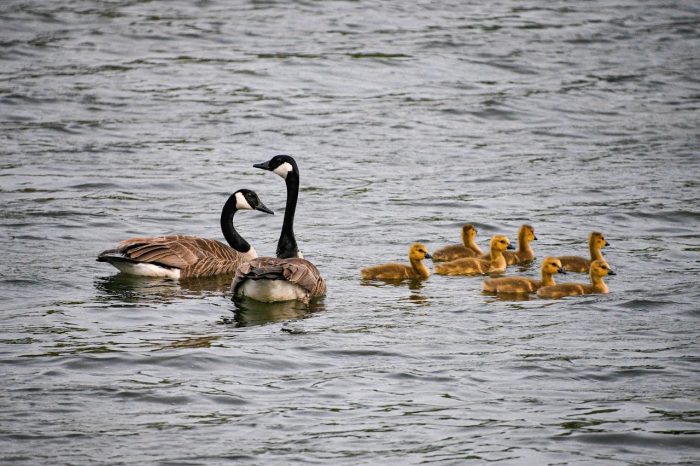{*Did you know you can write on Elephant? Here’s how—big changes: How to Write & Make Money or at least Be of Benefit on Elephant. ~ Waylon}
~
A tiny, downy gosling teetered dangerously on the ledge of the story-high office building.
It had taken hours of struggle and failure for the little guy to make the foot-high leap.
Now, on wobbly legs he wandered back and forth along the hot concrete, frantically chirping for his parents in the courtyard far below.
Then he took one last lap across the small expanse and walked right off the edge, plunging toward the sizzling concrete 14 feet below.
~
Revolutionary, sustainable, and wonderfully eco-conscious. That was the thinking behind the rooftop garden when it was built on the office building a year or two earlier. It would provide a bit of natural insulation and a nice, restful view for the people working in the taller building next door. It even provided a bit of a haven for the butterflies and bees.
All of this was nice, but we were sure we’d done Mother Nature the very best of good deeds when a pair of Canada geese built a nest and laid their eggs right there on our roof. We’d provided the birds with a quiet, grassy place to raise their young, safe from predators and lawnmowers.
And what an unexpected treat for us! From the hallway windows in the taller neighboring building, we could watch the mama protecting and caring for her eggs while the papa came and went. Later, a bigger crowd gathered in the corridor to watch as Mom fed her five tiny, newly hatched babies.
Then came the morning when we found Mama and Papa standing on the ground far below the rooftop garden honking loudly. Alone on top of the roof, the little goslings rushed frantically back and forth, trying over and over to scramble over that one-foot ledge that surrounded the garden, desperate to rejoin their parents on the ground.
The hallway was full of murmurs. What are Mama and Papa doing? Why don’t they just fly back up to the roof and help their babies?
A quick online search provided an explanation. When goslings are old enough, their parents lead them out in the world by leaving the nest, themselves, and honking for their babies to follow. The difference is, in their natural, water-side homes, the drop from the nest to the pond is only a few inches at most. Not the building-high drop they were facing today toward the relentless sidewalk below.
We honestly thought we’d provided this beautiful family with a wonderful safe haven. Instead, we’d inadvertently lured them into a concrete trap.
And when that little gosling dropped off the side of the building and vanished, we were sure it had just become a fatal trap, too.
My friend and I ran down the stairs, out of the building, and around the corner, terrified of what we might find. We were amazed and relieved to find the gosling alive and well. It appeared that he’d somehow missed the pavement and landed in the soft soil and vegetation in the flower bed edging the building. Now he was calmly shaking the dirt out of his down and waddling off to join his parents as if nothing unusual had just happened.
Another gosling made the same perilous leap but off the opposite side of the rooftop garden. We searched for it on the ground but were baffled when we found no trace of it. Then, back in the upper hallway, we saw a small shadow cast on a far wall of the rooftop. We were sickened to realize that the little bird had gotten trapped in a lower section of the roof where there wasn’t any grass or soil. Not even a drop of moisture. Just glaring concrete and smooth, tall, unclimbable walls on all sides. Surely the little bird would roast to death on that hot cement!
The mood of the observers in the hallway turned from delighted curiosity to distress and worry. Frantic e-mails flew around the office to maintenance and administration. Why wasn’t someone getting animal services out to manage the situation? Why didn’t someone call the fire department or the zoo? Why didn’t somebody do something to help these trapped, helpless goslings?
There was a door leading out of the garden, but it was accessible only to a small group of maintenance workers.
But it didn’t matter. Someone finally spoke to animal services and an email circulated warning us that the worst thing we could do would be to interfere. The parents might reject the babies if they came in contact with humans. The only thing to do, we were told, was to stay away and let the situation manage itself.
Even if it was in the worst possible way.
By the late afternoon, we knew the awful truth. Mama and Papa and the gosling who had made it off the roof had left the office complex. They had given up and left the four remaining babies on the rooftop garden to starve to death.
The day came to an end and there was nothing to do but go home. We didn’t fool ourselves into thinking we would be able to sleep that night.
What we didn’t know was that there was a plan.
Despite Animal Service’s warnings, late that evening, when the building complex was nearly deserted, someone with the proper training and equipment went out on the rooftop and gently collected all four of the remaining babies. The babies spend the night in the neighborhood veterinary clinic.
Early in the morning, Mama and Papa came back to the complex and were presented with their babies. Thankfully, they accepted their lost goslings with open wings! The human contact hadn’t phased them at all. The whole family was last seen tottering off, all together, in the direction of a nearby pond.
The geese never built another nest in that rooftop garden, again.
So, this story had a happy ending, but this problem is not uncommon, and the ending is not always so heartwarming.
We share this planet with millions of wild things and every day we make decisions that have a profound effect on their well-being. For generations, they’ve had to figure out how to adapt their lives around our buildings and highways. More often, of late, conscious efforts have been made to provide them with the spaces they need. Such was the case with the rooftop garden.
As those geese showed us, despite our best intentions, we don’t always get it right.
We’re like that gosling on the building ledge, teetering between what’s really the best thing for them and what will put them in terrible danger, but never really sure which is which.
So, the question remaining is, which way will we leap? And where, exactly, will we land?
~
{Please consider Boosting our authors’ articles in their first week to help them win Elephant’s Ecosystem so they can get paid and write more.}







Read 1 comment and reply